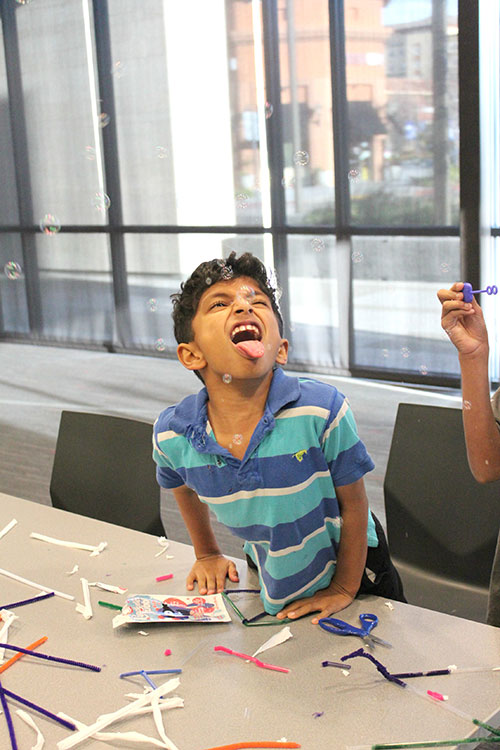
“When you have snot in your nose and you blow air from your nose, the mucus traps the air and forms a bubble,” said Angela Ocana, librarian at Northside Library, describing the science behind how one kind of bubble is formed. The attendees, children in grades two to six, learned this and more about bubbles at the afternoon workshop of Northside Library’s March 4 Science Day.
“We have an awesome grant from the Yahoo Employee Foundation (YEF); YEF gave us the money for the programming and they work with the library foundation,” Ocana said. “Everyone enjoys bubbles. If we can explain some of the science behind bubbles, we can teach while having a lot of fun.”
Ocana walked the children through what basic bubbles are. The slide on the screen read: “Bubbles are pockets of soap and water that are filled with air. When soap and water are mixed together and air is blown into the mixture, the soap forms a thin skin or wall and traps the air, creating a bubble.”
Using pipe cleaners and drinking straws, the children built bubble blowers, which are contraptions intended to hold bubbles. After dipping their bubble blowers into a giant box of bubble solution, the children released the bubbles. (The bubble solution was made from a gallon of distilled water, 2/3 cup of Dawn soap, and one tablespoon of glycerin.) Ocana pointed out that no matter what shape the bubble started out as within the bubble blower, once the bubble was released, its structure was always round.
Next, Ocana warned children not to touch the burning dry ice she was keeping inside another box. Then she conducted an experiment where she blew bubbles over the dry ice. The children marveled at the bubbles that seemed to magically float inside the box holding the dry ice.
“As dry ice turns from a solid to a vapor, it produces carbon dioxide gas,” Ocana said. “This gas is denser than air. The gas is on the bottom and the bubbles rest on top.”
After this activity, Ocana handed out packets of bubble treats called Candylicious Bubbles that read “Bubbles you can eat!” on the packaging. Children blew the candy bubbles, chased them and attempted to catch cherry or grape flavored bubbles with their tongues. Ocana advised the children not to eat candy bubbles alone as a meal staple and that regular bubbles made from soap were off limits altogether.
During the final activity, children gathered in teams and tried to catch as many bubbles as they could with their fingers. These bubbles came from a special solution.
“This solution is thick and helps create a strong membrane around a bubble,” said Ocana, explaining why bubbles from this solution were pop-resistant.
Earlier in the day, the library hosted workshops about dinosaurs and ancient fossils and building with Duplo Lego bricks. About 200 attendees participated in this year’s Science Day.





